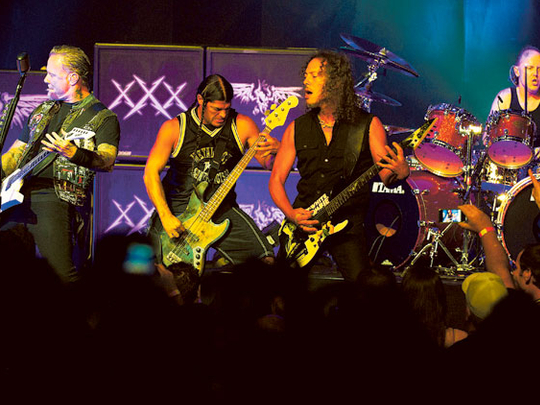
Singer and guitarist James Hetfield wore a familiar trickster grin and a pair of 3D glasses as he bobbed his head to the thundering riffs of Enter Sandman, but it was a different sort of arena that was playing host to the world’s bestselling hard-rock band.
Metallica had come to Comic-Con International in July to premiere the trailer for its movie Metallica Through the Never, and the charismatic frontman had turned his chair to watch the clip unspool along with the 6,500 fans in the San Diego Convention Center’s main hall. Towering likenesses of the musicians strode across a massive stage outfitted with electric charges, laser lights and fire pots, while a young roadie encountered an angry mob led by a mysterious figure on horseback known as the Death Dealer.
“It’s our ‘Apocalypse Now,’” drummer Lars Ulrich said.
Opening on Thursday at the Imax Ibn Battuta (and at non-Imax theatres on October 17), Metallica Through the Never is part genre fable, part concert movie, channeling the band’s predilection for apocalyptic imagery through a cinematic lens.
The film, directed by Nimrod Antal (Predators, Vacancy), stars actor Dane DeHaan as a runner named Trip who sets out on an errand for the group just as it’s taking the stage for a show. Hetfield and his bandmates — drummer Ulrich, guitarist Kirk Hammett and bassist Robert Trujillo — roll through a greatest-hits set list as Trip is drawn into the chaos that’s consumed the surrounding streets. As he fights his way back, things begin to go awry on stage, possibly a result of dark forces at work in the city.
The idea for a Metallica Imax movie dates to 1997 when the band’s management team first approached the musicians about shooting a concert film, then conceived as a conventional 30-minute short. But the massive cameras that the format required at the time turned out to be too unwieldy to be arranged on a stage, and the project was shelved until three years ago, when the group was on tour in Belfast.
“There was a realisation that a lot of our fans were so young that the theatrical elements of Metallica’s stage presentations from the ‘80s, a lot of them hadn’t seen — statues and crosses and all this crazy stuff,” said Ulrich, 49, seated beside Hetfield, Hammett and Trujillo under the fluorescent lights of a hotel ballroom. “You could do so much more with the technology of that now, so to revisit that carefully without going too far and being stuck in the past [seemed appealing].”
In the four decades since Ulrich and Hetfield met and formed the band in 1981, Metallica has sold more than 110 million albums, forging a reputation as a powerhouse live act whose muscular, masculine energy on stage magnified the sonic force of songs about violence and death and Old Testament-style retribution.
The band has an extensive history with film too — it was Dalton Trumbo’s 1971 anti-war screed Johnny Got His Gun that inspired the group’s 1989 single One, a nightmarish first-person account of a soldier who loses his arms and legs, his sight, hearing and speech to a land mine. The long-form version of the groundbreaking video for the song intercut between scenes from the movie and shots of Metallica performing.
It was the 2004 warts-and-all documentary Some Kind of Monster, however, that might have had the most profound influence on the direction of Metallica Through the Never. Joe Berlinger and Bruce Sinofsky’s chronicle of the band during the recording of its St. Anger album charted artistic and personal clashes, as Hetfield returned to the group after a stay in rehab to treat alcohol addiction and Trujillo was tapped to replace longtime bass player Jason Newsted.
“What we learned from the Some Kind of Monster experience is if you have a dramatic arc in your film, it puts a whole different spin on it,” Ulrich said. “There were a lot of music-world people that thought the movie was way too transparent and there was too much stuff that you shouldn’t see, but the film world received it warmly. It’s not really a movie about a rock ‘n’ roll band, it’s a movie about relationships.”
For Metallica Through the Never, the group selected 16 tracks stretching back to its 1983 debut album, Kill ‘Em All, and tapped British architect Mark Fisher (who provided concert designs for Pink Floyd’s The Wall) to construct a massive stage, 200 feet long and 60 feet wide, with various trap doors and risers to allow for some outsize theatrical elements, and a floor made entirely of LED screens.
To develop the narrative, the band turned to Antal, a lifelong Metallica fan who earned early acclaim for his Hungarian-language subterranean thriller Kontroll. He invented the Trip character, whose largely wordless journey was informed, in part, by the circular structure of Paulo Coelho’s novel The Alchemist.
“He totally understands Metallica and what we’re about,” said Hammett, 50. “He understands our audience, and he understands how passionate our audience is and how intense our audience is.”
The band played a string of concerts in Mexico City last year to familiarise itself with Fisher’s stage before travelling to Canada to shoot the film. Performing on the set, which takes up the entire ice floor of a standard hockey arena, required great care, and the musicians were amused and somewhat alarmed by the precautions that were necessary.
“You’re playing a song, and by the way, don’t go in this little area — there’s a Tesla coil that shoots off 10,000 volts and you could get killed,” said Hetfield, 50.
“Don’t pass this little piece of masking tape with a little X on it or you’ll get fried,” Hammett added.












